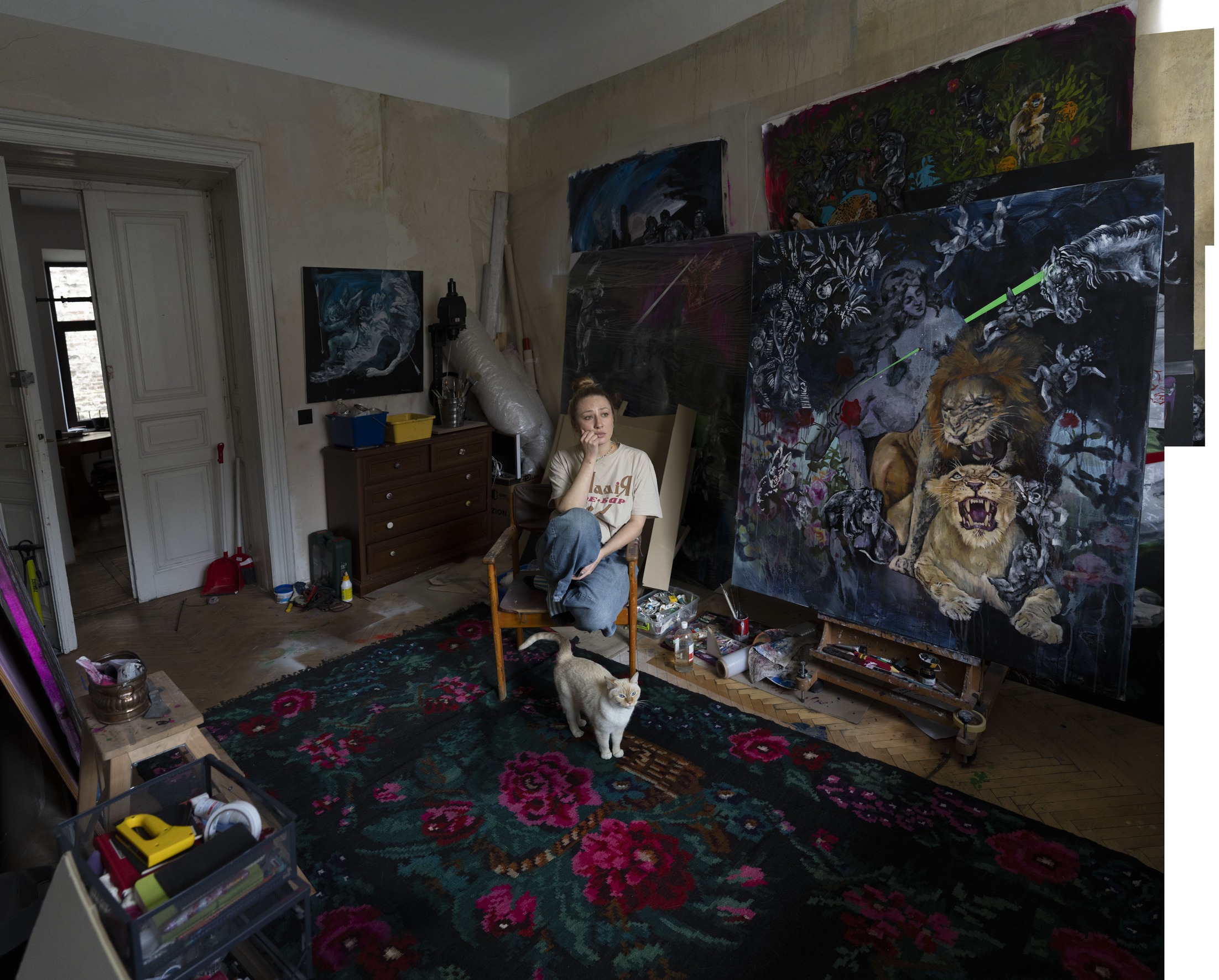Мирослава Бачкур
Myroslava Bachkur
«Стрес накопичується, часто непомітно, і зрештою вибухає. Тому важливо не лише зберігати своє психічне здоров’я, а й бути уважним до стану тих, хто поруч».

З серії «Before the Future», 2025
Друк на Hahnemuhle Photo Rag Metallic, Dibond
Перші два роки після початку повномасштабного вторгнення Мирослава Бачкур продовжувала працювати й брати участь у подіях, вести активну мистецьку діяльність, але «через силу». Потреба тримати процеси й не зупинятися переважала над внутрішнім станом втоми. Згодом настало вигорання. Виникло відчуття власної незначущості, ніби ти – остання ланка в системі, де твоя робота вже не має сенсу. І з цим прийшла тиша, не зовнішня, а внутрішня, яка паралізувала бажання творити.
Родина й друзі залишилися в безпеці, але війна стала постійною присутністю. Є відчуття колективної травми: зруйновані зв’язки, втрачені покоління, досвід, що не піддається поясненню. Найчастіше в голові звучить питання: навіщо це все?
Стрес накопичується, часто непомітно, і зрештою вибухає. Тому важливо не лише зберігати своє психічне здоров’я, а й бути уважним до стану тих, хто поруч. Основним джерелом енергії стала комунікація з іншими людьми. Особливо з тими, хто не здається, хто продовжує працювати та підтримувати інших. Спілкування, обмін досвідом чи, наприклад, улюбленими піснями дозволяють залишатися в присутності, навіть коли ресурс мінімальний.
Щоб не зламатися остаточно, Мирослава припинила виставкову та проєктну діяльність і змінила фокус – почала вчитися motion-дизайну. Це дало технічну впевненість, нові навички та відчуття, що щось залишається під контролем. В останніх художніх роботах багато штрихування, повторень, автоматизму. Це можна порівняти з прибиранням вдома або приготуванням їжі: прості дії, які дають змогу тримати себе в тонусі й уникати перевантаження думками. Світ, у якому новини змінюються щогодини, породжує відчуття хаосу, і саме тому нові роботи набули абсурдності та фрагментарності.
Мистецтво сьогодні – це питання без остаточної відповіді. Є певний емоційний дисонанс: раціональне розуміння важливості мистецтва, але відсутнє емоційне відчуття його значущості. Зникла віра – той внутрішній мотор, що раніше запускав процес. Тепер головне поступово його перезапустити. Художниця переконана: щоб повернутися до активної практики, потрібно спочатку наповнити себе.
‘Stress accumulates — often invisibly — and eventually explodes. That’s why it’s vital not only to protect your own mental health but also to stay attuned to the state of those around you.’
For the first two years after the full-scale invasion, Myroslava Bachkur kept working, participating in events, staying active in the art scene — but it was all by force. The need to keep things moving, to not stop, outweighed her internal fatigue. Eventually, burnout set in. A sense of irrelevance took hold, as if she were the last, dispensable link in a chain — her work no longer carrying meaning. And with that came silence. Not external, but internal. A kind of stillness that paralysed her desire to create.
Her family and friends remained safe, but the war became a constant presence. There was a persistent sense of collective trauma: broken connections, lost generations, experiences too complex to explain. One question kept echoing in her mind: what is all this for?
Stress, she notes, builds up silently — and then erupts. That’s why it’s not only important to maintain your own mental stability but also to remain attentive to the condition of others. The main source of her energy became communication with people who did not give up, who continued to work and support others. Conversations, exchanging experiences, sharing favourite songs — these became lifelines, ways to stay present, even when the inner resource felt depleted.
To avoid complete collapse, Myroslava paused her exhibition and project work and shifted her focus. She began studying motion design. The technical precision gave her new skills — and a sense that something was still within her control. Her recent artworks are filled with repetitive gestures, hatching, and automation. Like cleaning the house or cooking, these simple actions help keep the mind grounded and prevent emotional overload. In a world where headlines change every hour, such gestures offer small islands of order.
Art today, for her, is a question without a definitive answer. There is an emotional dissonance: a rational understanding of the importance of art, but a lack of emotional connection to its meaning. The inner faith that once powered her work — the inner motor — has stalled. The task now is to gradually restart it.
Myroslava is convinced: in order to return to active practice, one must first restore oneself.